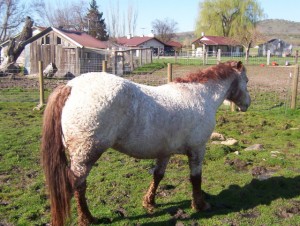Animals
Catatonic Rats
Old science books and articles are a great source of weird images. For instance, I found the two pictures below in Of Mice, Men and Molecules by John Heller (published in 1960). The images are titled "Catatonic rats" and have this explanatory caption:Unfortunately, Heller doesn't reveal what the chemical is that caused the rats to freeze in these positions. My guess is that it's LSD.
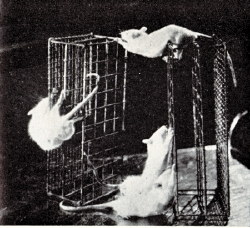 | 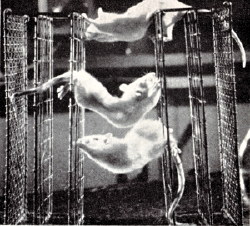 |
Posted By: Alex - Mon Aug 18, 2008 -
Comments (3)
Category: Animals, Drugs, Science, Experiments
Follies of the Mad Men #12
Yes, I want my beer to be endorsed by a drunken chipmunk who's been taking fashion lessons from Andy Capp.Amazingly, despite this appalling choice of spokes-mammal, Stegmaier Beer remains in business to this day, as you can see if you follow the link.
Any reader ever tasted a "Steg"?
Posted By: Paul - Thu Aug 14, 2008 -
Comments (5)
Category: Animals, Business, Advertising, Products, Inebriation and Intoxicants, Regionalism, Comics
Real Horse That Looks Like Stuffed Toy
Here at WU Central, the proprietors believe in training up the next generation to be observant and appreciative of all things weird. Hence the photo you see here.This image was taken by my tweener niece, Becky Fuller, at the farm my brother Frank and his wife Beverly own in Medford, Oregon. It depicts a curious beast Becky calls "the curly horse."
Becky is enrolled in 4-H, and they've plainly been conducting secret experiments to hybridize sheep and horses. How else to explain the odd woolly fur of this anomalous quadruped, its mullet-like mane, or the unnaturally symmetrical appearance of its brown "stockings"?
Be afraid--be very afraid!
Posted By: Paul - Thu Aug 14, 2008 -
Comments (6)
Category: Agriculture, Animals, Domestic, Family, Photography and Photographers
Stop massaging that horse!
Maryland-resident Mercedes Clemens has been forced to shutter her horse massage business. Although she's certified to massage humans, she's not certified to massage animals. According to the Associated Press:In other news, THERE ARE ANIMAL MASSAGE REGULATIONS!
(Thanks, Big Gary!)
Posted By: Alex - Tue Aug 12, 2008 -
Comments (3)
Category: Animals, Regulations
Dogs Catch Human Yawns
I imagine that many dog owners have noticed that dogs can "catch" yawns from humans, and vice versa (I think). So was an experiment to verify this really necessary? The animal behaviorists at the University of London evidently thought so. In their defense, I'd argue that just because something seems obvious, it still might yield interesting results when examined under controlled conditions in a laboratory setting. From the Aug 2008 issue of Biology Letters:The BBC has a video of a yawning dog -- making me sleepy! (Thanks, Sandy!)
Posted By: Alex - Sun Aug 10, 2008 -
Comments (1)
Category: Animals, Experiments
Home Intruder
I have no explanation for this video. But it seemed to belong on WEIRD UNIVERSE.You have been warned.
ADDENDUM: Clear-headed and far-sighted reader Fitz identifies the URL touted onscreen here as totally NSFW. I found the video itself on YouTube.
Posted By: Paul - Mon Aug 04, 2008 -
Comments (8)
Category: Animals, Buildings and Other Structures, Domestic, Unsolved Mysteries
Mystery Bug Invades Britain
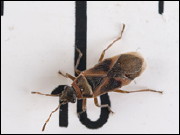
Despite containing more than 28 million insect specimens, the museum failed to find an exact match for the new bug. Experts said it closely resembles the rare species Arocatus roeselii that is usually found in central Europe. But the roeselii bugs are brighter red than this new bug and they are usually associated with alder trees. The National Museum in Prague discovered an exact match to the mystery insect but experts there have also failed to determine exactly what it is. "It seems strange that so many of these bugs should suddenly appear," said Mr Barclay.
Sure, it appears to be harmless for now, but what are the odds it'll remain that way? Haven't they read The Day of the Triffids?
Posted By: Alex - Wed Jul 30, 2008 -
Comments (2)
Category: Animals, Horror, Unsolved Mysteries, Science Fiction
Monkeys on Opium
Reported in November 1887 in the Pall Mall Gazette:And more recently, in a July 2008 BBC News article about the world's largest legal opium factory located in Ghazipur in northern India:
Monkeys still have the run of the factory, eating opium waste and dozing all day. "They have become addicted to opium. Most of the time we have to drag dozing monkeys away from this place," a worker says.
Posted By: Alex - Wed Jul 30, 2008 -
Comments (0)
Category: Animals, Inebriation and Intoxicants
Monkey Pig Scares Chinese
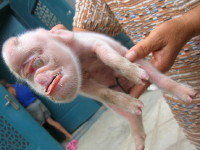
Back in July 2005 there were reports that the Chinese were planning to send pig sperm into space aboard the Shenzhou VI spacecraft. The plan was to expose the sperm to cosmic rays and microgravity and then fertilize pigs back on earth with it -- just to see what would happen. But to my knowledge, there were never any follow-up reports about the experiment. Could there be a link between the space-pig experiment and Feng Changlin's monkey-pig? Inquiring minds want to know.
On a more down-to-earth note, if you're interested in odd-looking creatures (and who isn't?) check out Sarah Hartwell's incredible site, messybeast.com.
Posted By: Alex - Sun Jul 27, 2008 -
Comments (0)
Category: Animals

| Who We Are |
|---|
| Alex Boese Alex is the creator and curator of the Museum of Hoaxes. He's also the author of various weird, non-fiction, science-themed books such as Elephants on Acid and Psychedelic Apes. Paul Di Filippo Paul has been paid to put weird ideas into fictional form for over thirty years, in his career as a noted science fiction writer. He has recently begun blogging on many curious topics with three fellow writers at The Inferior 4+1. Contact Us |


